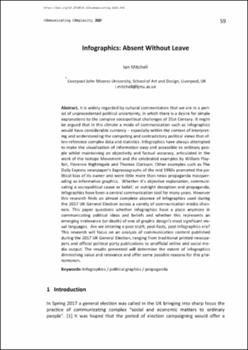Infographics: Absent Without Leave
Autor
Mitchell, IanFecha
2020Resumen
Abstract. It is widely regarded by cultural commentators that we are in a peri-
od of unprecedented political uncertainty, in which there is a desire for simple
explanations to the complex sociopolitical challenges of 21st Century. It might
be argued that in this climate a mode of communication such as infographics
would have considerable currency – especially within the context of interpret-
ing and understanding the competing and contradictory political views that of-
ten reference complex data and statistics. Infographics have always attempted
to make the visualisation of information easy and accessible to ordinary peo-
ple whilst maintaining an objectivity and factual accuracy, articulated in the
work of the Isotope Movement and the celebrated examples by William Play-
fair, Florence Nightingale and Thomas Clarkson. Other examples such as The
Daily Express newspaper’s Expressographs of the mid 1950s promoted the po-
litical bias of its owner and were little more than news propaganda masquer-
ading as informative graphics. Whether it’s objective explanation, communi-
cating a sociopolitical cause or belief, or outright deception and propaganda,
infographics have been a central communication tool for many years. However
this research finds an almost complete absence of infographics used during
the 2017 UK General Election across a variety of communication media chan-
nels. This paper questions whether infographics have a place anymore in
communicating political ideas and beliefs and whether this represents an
emerging irrelevance (or death) of one of graphic design’s most significant vis-
ual languages. Are we entering a post-truth, post-facts, post-infographics era?
This research will focus on an analysis of communication content published
during the 2017 UK General Election, ranging from traditional printed newspa-
pers and official political party publications to unofficial online and social me-
dia output. The results presented will determine the extent of infographics
diminishing value and relevance and offer some possible reasons for this phe-
nomenon.





